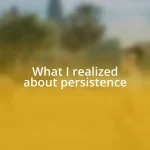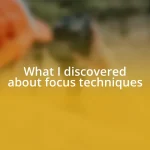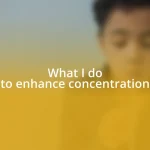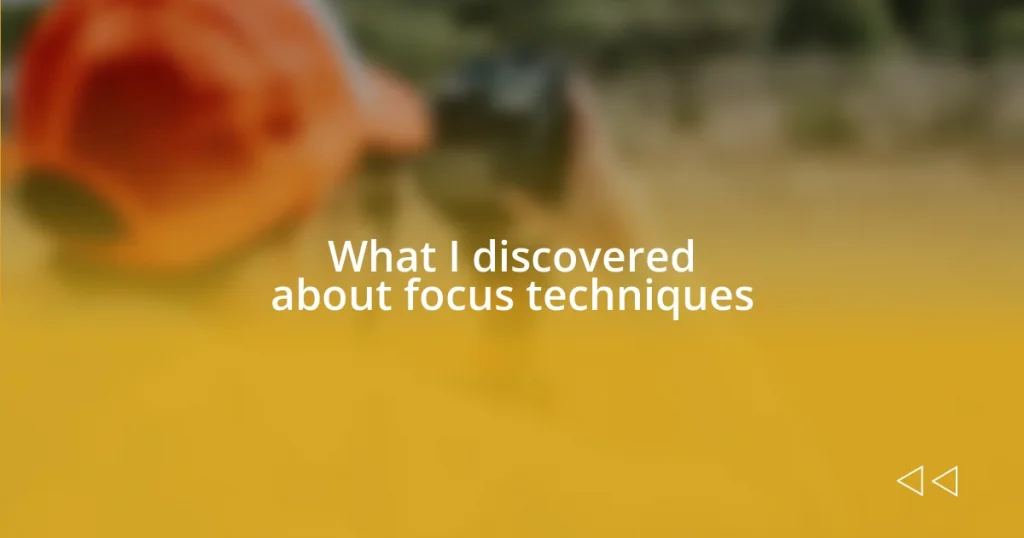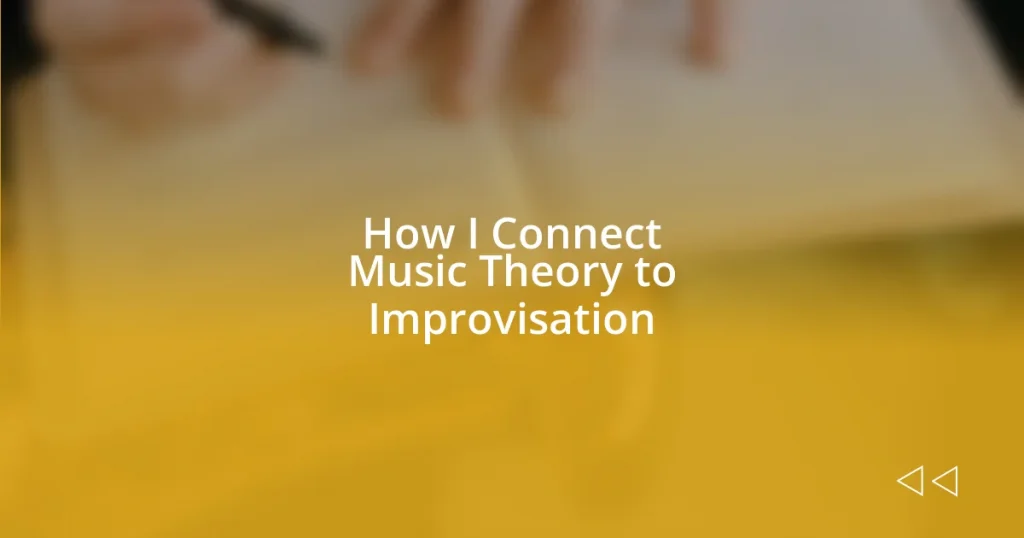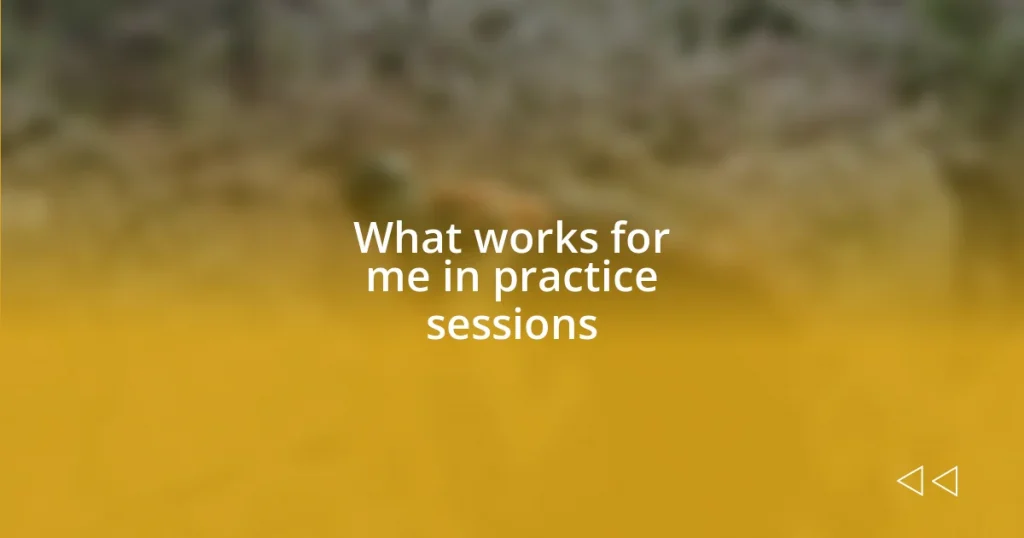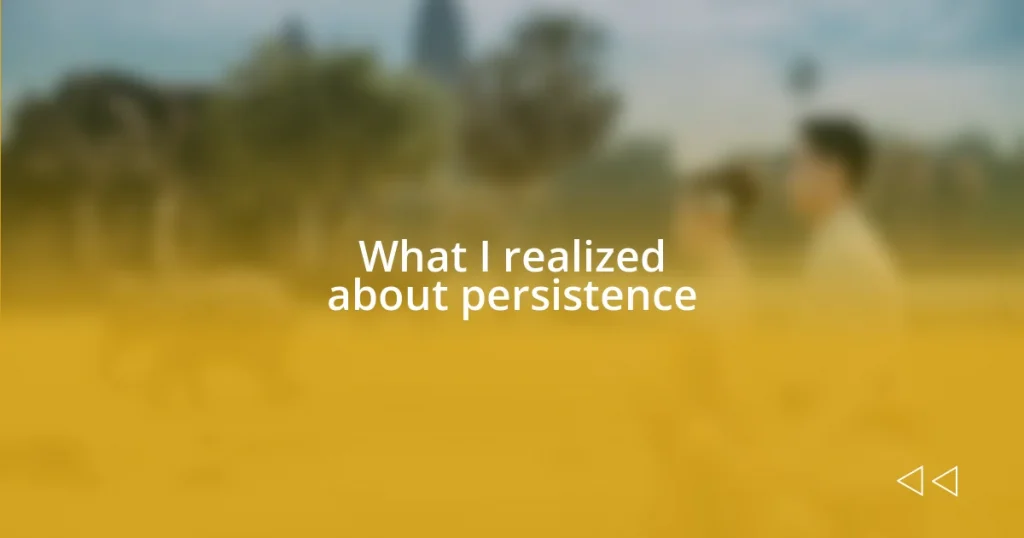Key takeaways:
- The Pomodoro Technique and mindfulness meditation are effective strategies for enhancing focus and productivity.
- Creating distraction-free zones and leveraging technology can significantly reduce interruptions, boosting concentration.
- Building a personalized focus routine by identifying optimal working times and integrating various techniques can enhance overall productivity.
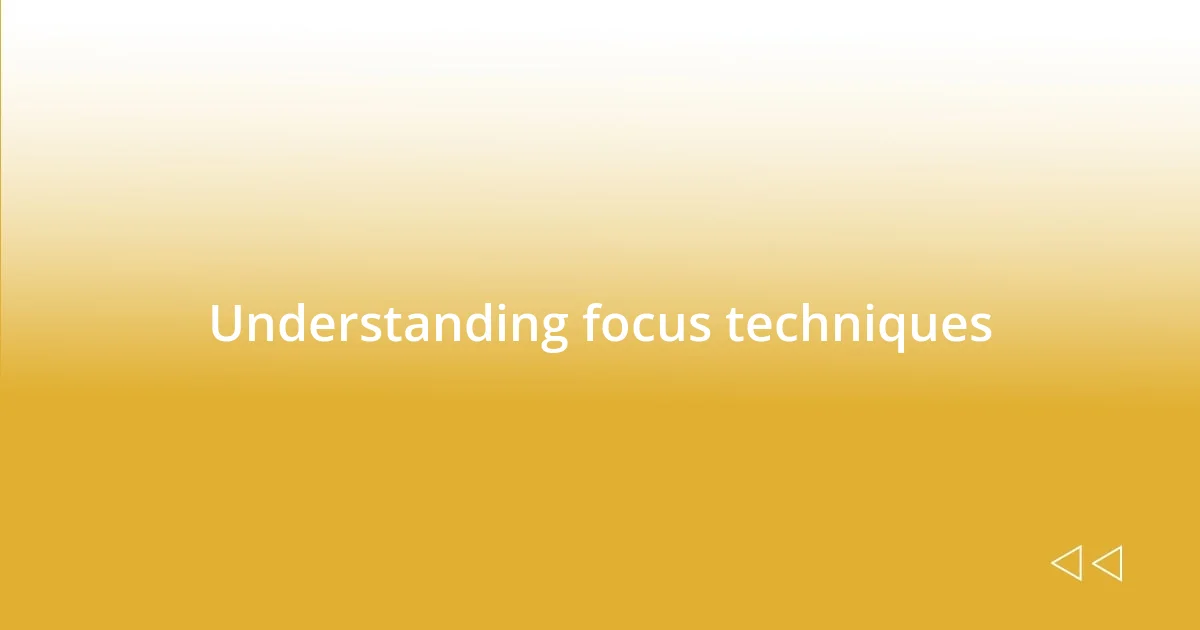
Understanding focus techniques
Understanding focus techniques means diving into strategies that can genuinely enhance our ability to concentrate. I’ve found the Pomodoro Technique, for example, immensely useful. When I first tried it, I was skeptical—how could 25 minutes of work followed by a 5-minute break really help? Yet, I discovered that those short bursts of productivity not only kept my attention sharp but also allowed me to tackle tasks I had been avoiding.
Another method I’ve explored is mindfulness meditation. I remember sitting quietly, trying to quiet my racing thoughts, and realizing how challenging it truly was. But with consistent practice, I began to notice a difference in my daily focus. Have you ever experienced that moment of clarity when your mind feels free from clutter? It’s incredible how simple breathing exercises can ground us, providing a solid base to build our concentration on.
Ultimately, understanding focus techniques is about finding what resonates with us personally. I encourage you to experiment with different methods and see what works best for you. What if a technique you’ve never considered could unlock the focus you’ve been searching for? It’s all about being open to discovery and growth in our quest for better concentration.
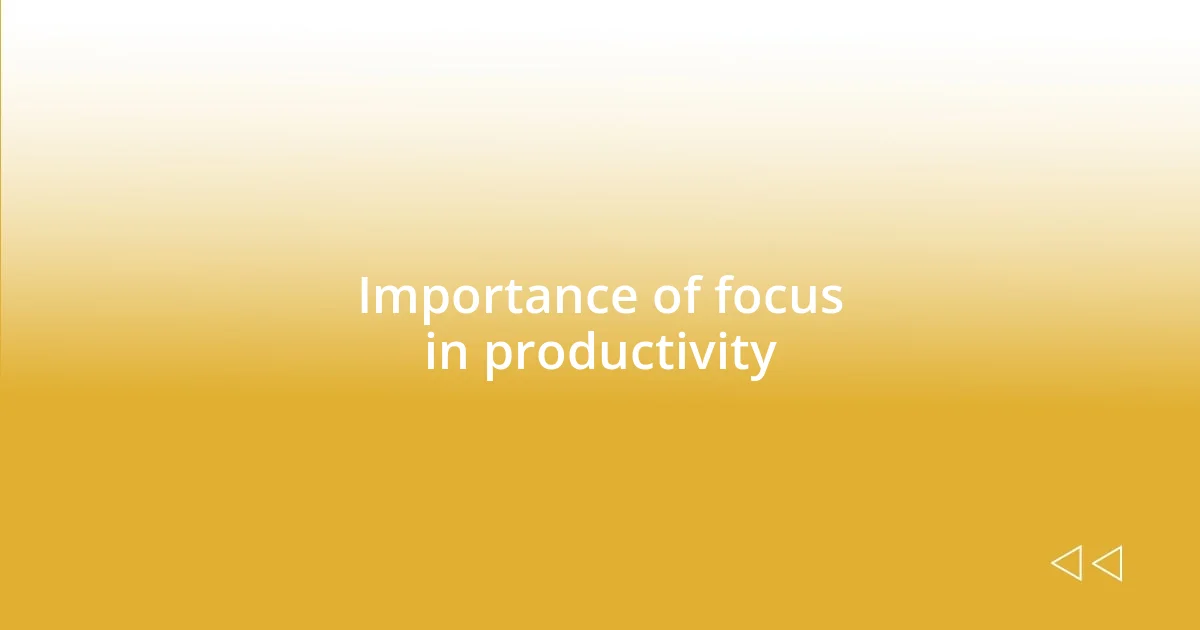
Importance of focus in productivity
Staying focused is crucial for productivity—it’s amazing how much we can accomplish when our minds are clear. I remember a day when I decided to eliminate distractions for just two hours. The result? I completed a project that had been lingering for weeks, and that surge of accomplishment was exhilarating. That experience taught me that focus isn’t just about higher output; it’s about quality too.
Here are a few key points that highlight the importance of focus in productivity:
- Enhanced clarity: A focused mind allows for clearer thinking and better decision-making.
- Reduced errors: Concentration minimizes mistakes, saving time and effort in corrections.
- Increased creativity: When distractions fade, creative ideas can flow more freely.
- Greater satisfaction: Completing tasks efficiently fosters a sense of achievement, boosting morale.
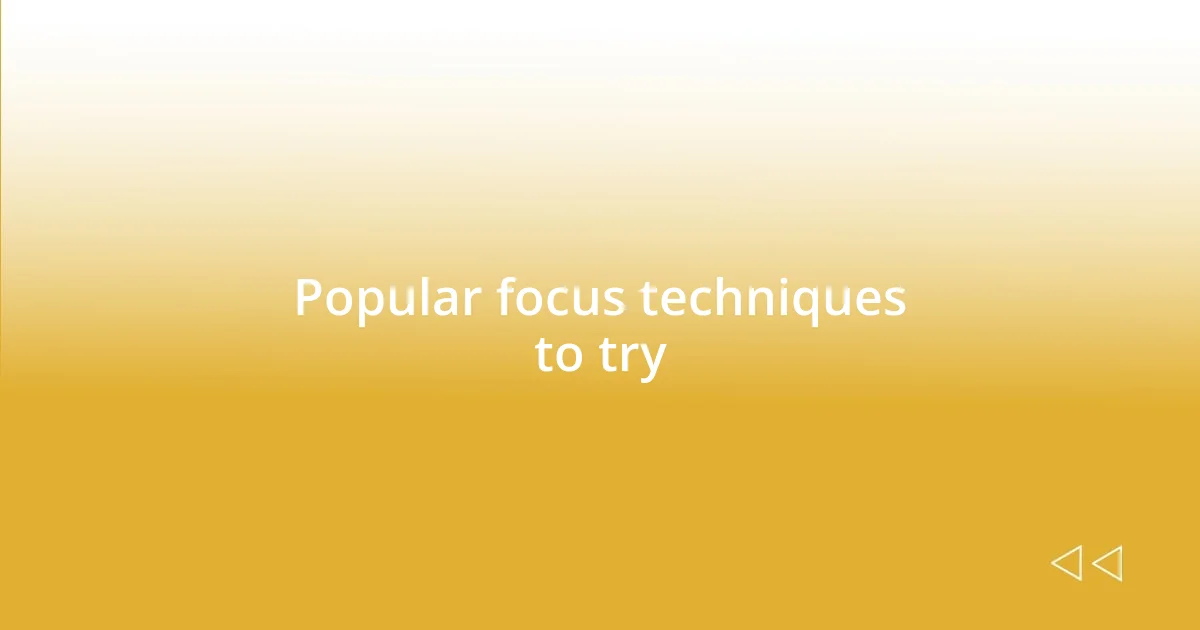
Popular focus techniques to try
Exploring different focus techniques can feel like a journey filled with surprises. One method I can’t recommend enough is the ‘Two-Minute Rule.’ Whenever I encounter a task that takes less than two minutes, I tackle it right away. It’s fascinating how quickly those little tasks add up—and then I realize I’ve cleared a big chunk of my to-do list with minimal effort! Have you ever tried this? It really shifts the burden of daunting tasks to manageable bites.
Another technique I’ve found particularly effective is environmental design. It might sound simple, but rearranging my workspace made a world of difference. I decided to declutter my desk of distracting items and surround myself with things that inspire creativity. The transformation was incredible—suddenly, I felt a renewed sense of focus. How does your environment influence your attention? For me, a clear space equals a clear mind.
Lastly, I’ve experimented with time blocking, where I schedule specific blocks in my calendar dedicated solely to particular tasks. Initially, I was nervous about sticking to the timeline, but I soon learned to embrace the structure. It’s a fantastic way to allocate focus and avoid multitasking, which I’ve realized only diminishes productivity. What strategies do you think would work best for you? Each technique offers unique benefits, and finding one that feels right can be a real game-changer.
| Technique | Description |
|---|---|
| Pomodoro Technique | Work for 25 minutes followed by a 5-minute break to enhance focus. |
| Two-Minute Rule | Complete any tasks that take less than two minutes immediately. |
| Mindfulness Meditation | Practice being present to improve concentration and clarity. |
| Environmental Design | Optimize your workspace to reduce distractions. |
| Time Blocking | Schedule specific times for particular tasks to maintain focus. |
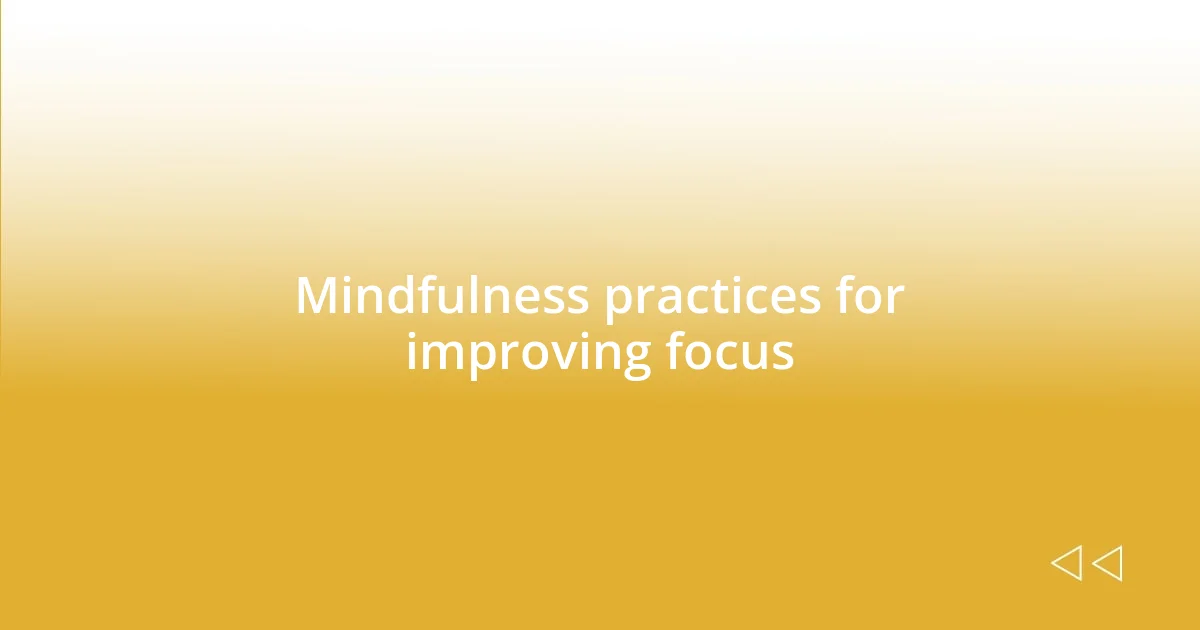
Mindfulness practices for improving focus
One of the most transformative mindfulness practices I’ve discovered is mindfulness meditation. When I first started, I was skeptical—could sitting still really enhance my focus? But as I began to dedicate just a few minutes each day to this practice, I noticed something remarkable. With consistent practice, I found it easier to redirect my attention when distractions popped up, and my ability to concentrate on tasks improved significantly. Have you ever given yourself the gift of just being present? It’s truly a game-changer.
Incorporating mindful breathing exercises into my daily routine has also been a revelation. Whenever I feel my mind drifting, I take a moment to focus on my breath. The simple act of inhaling deeply and exhaling slowly grounds me and helps clear mental clutter. I remember a particularly hectic day at work when I faced a tough deadline. Just pausing for a few breaths allowed me to reset and tackle the task with renewed clarity. Isn’t it amazing how a few moments of mindfulness can create such a positive ripple effect?
Additionally, I’ve found that integrating body scans into my mindfulness practice enhances my overall focus. As I consciously move my attention through various parts of my body, I become increasingly aware of how tension can impede my concentration. One enlightening experience was when I realized that tension in my shoulders was pulling my thoughts away from the task I needed to focus on. This awareness not only helps me release physical pressure but also reminds me to return to my goals with a clearer mindset. What areas in your body might be holding onto stress, and how could releasing that tension allow you to focus better?
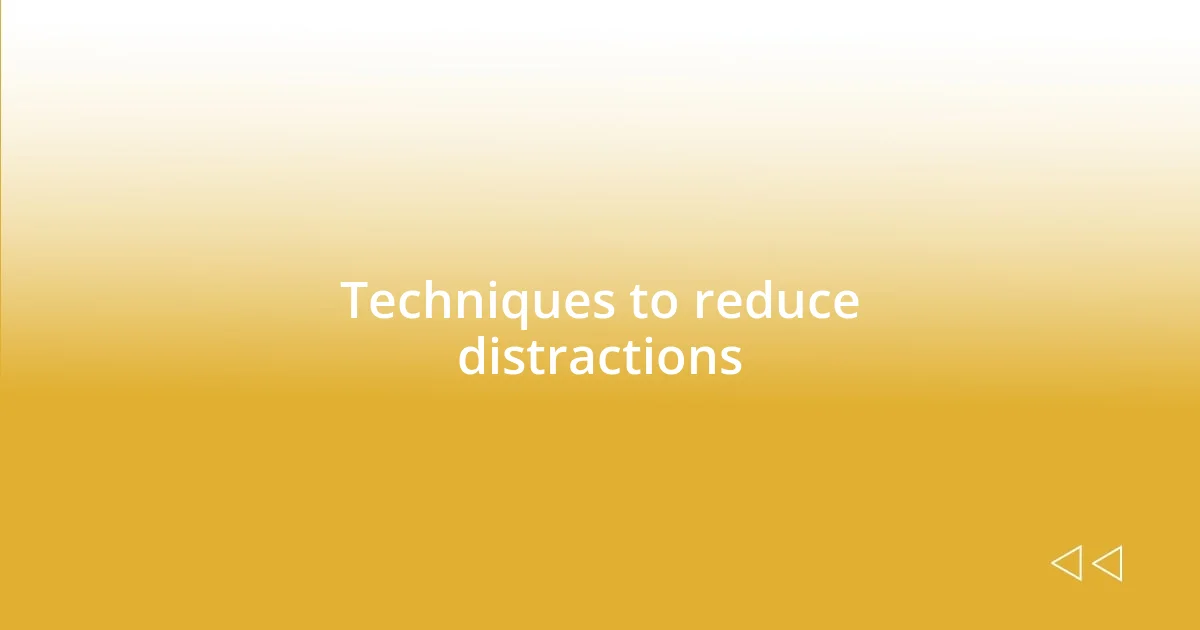
Techniques to reduce distractions
Reducing distractions can be a game-changer for anyone looking to boost their focus. One technique that I’ve employed is creating designated “distraction-free zones.” I’ve designated specific areas in my home where I can work or think without interruptions—no phone, no TV, just a clear space dedicated to concentrating. Initially, I was skeptical about whether this separation would truly matter, but I can confidently say that it has empowered me to dive deeper into my tasks. How do you set boundaries to ensure you stay productive in your environment?
Another method I’ve found invaluable is employing technology to my advantage. There are apps designed to block distracting websites while I’m working, and using them has been a revelation. I remember a time when I fell into a YouTube rabbit hole because I just wanted a quick break. By blocking those sites, I’ve regained those lost hours and redirected that energy into more meaningful tasks. Have you considered harnessing technology to minimize the distractions of the digital age?
Lastly, I pay close attention to my schedule and prioritize my tasks. Breaking my to-do list into smaller, more manageable chunks has helped reduce overwhelm and limit distractions. There were days when I’d look at a lengthy list and feel completely paralyzed. By focusing on just one task at a time, I not only enhance my productivity but also create a sense of accomplishment that motivates me to continue. Have you noticed how focusing on fewer tasks at once can change your day?
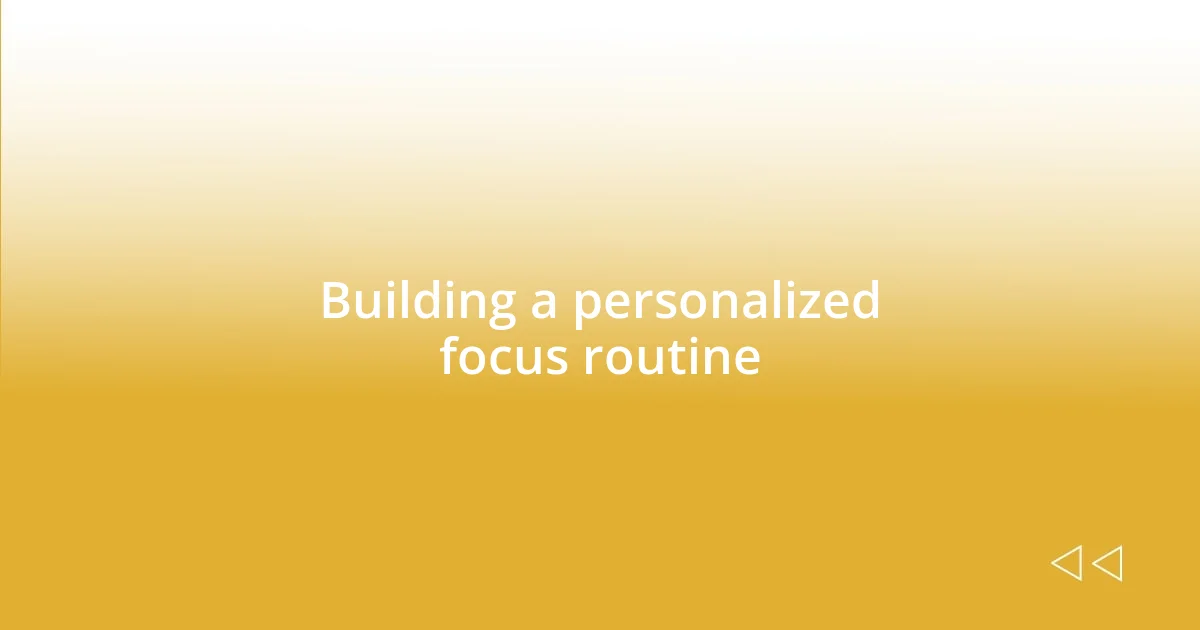
Building a personalized focus routine
Building a personalized focus routine begins with identifying what uniquely resonates with you. For me, setting specific times of the day when I feel most alert has been incredibly effective. I’ve noticed that my brain is like a sponge in the morning, soaking up information and completing complex tasks with ease. Have you ever noticed a time when you just flow effortlessly through your work? Find those windows and harness that natural energy.
Creating a blend of techniques also plays a key role in developing an effective focus routine. I combine the Pomodoro Technique with a short yoga session before diving into my work. The intervals of focused work followed by brief movement shifts not just my energy levels but also revitalizes my mind. One day, I had been stuck on a project until I decided to take a quick stretch break. That simple decision sparked ideas that I hadn’t considered before. How can you mix different approaches to create a routine that energizes you?
Lastly, I’ve found that journaling intentions for my focus sessions helps clarify what I want to achieve. Writing down my goals, even if they’re small, gives my mind a direction to follow. One particularly busy week, I jotted down a list of three key tasks each day. Not only did this help me stay on track, but crossing those off felt like a mini celebration! What if you started each day with simple intentions? Imagine the sense of accomplishment you could cultivate by being intentional about your focus.


